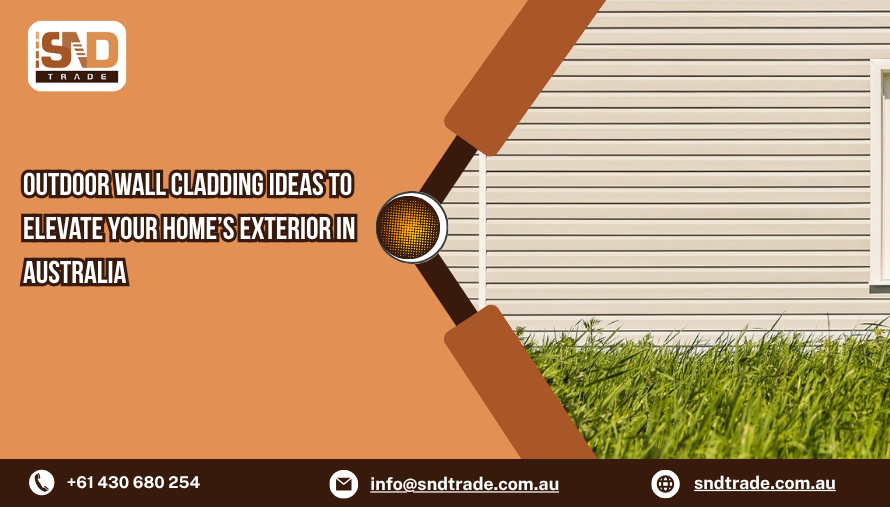Australians are embracing modern, durable, and weather-resistant materials for transforming their home’s exterior—making outdoor wall cladding ideas a top design trend in 2025. Whether you live by the coast, in the suburbs, or in the outback, the right cladding not only enhances curb appeal but also provides thermal insulation, weather protection, and long-term value.
From timber battens to WPC exterior wall cladding, there’s a wide range of solutions to suit every architectural style. You can browse premium options from wpc exterior wall cladding suppliers to explore long-lasting and eco-friendly choices gaining popularity across Australia.
Let’s dive into the top outdoor cladding ideas trending in Australian architecture today.
1. WPC Cladding – Eco-Friendly & Modern
WPC (Wood Plastic Composite) cladding is fast becoming a favourite in Australian exterior design due to its low maintenance, durability, and sleek timber-look finish. It’s ideal for homes seeking a modern, minimalist, or even coastal vibe.
Why Choose WPC?
- UV and water-resistant
- Doesn’t rot or attract termites
- Looks like real wood without the upkeep
2024 Trend: Vertical WPC panels in grey, walnut, or teak finishes for Hamptons-style and minimalist homes.
2. Timber Battens for a Natural Aesthetic
Real hardwood cladding offers warmth and a timeless appeal. Popular species include Blackbutt, Spotted Gum, and Ironbark. While it needs regular oiling or sealing, many homeowners still prefer it for its authentic look.
Pro Tip: Use a combination of vertical and horizontal battens for a dynamic, architectural look.
3. Stone Veneer Cladding for a Premium Finish
If you’re aiming for luxury and longevity, stone cladding is your go-to. Think stacked limestone, sandstone, or granite walls. They’re particularly suitable for feature walls, entranceways, and garden retaining walls.
Popular Applications:
- Poolside walls
- Alfresco dining zones
- Outdoor fireplaces
According to a 2024 Houzz Australia survey, 34% of homeowners now consider natural stone cladding for outdoor renovations, especially in bushfire-prone areas due to its fire resistance.
4. Brick Cladding with a Twist
Gone are the days of red clay bricks being your only choice. Today’s brick cladding comes in slimline, white-washed, and dark charcoal versions that work well with industrial, coastal, and heritage home styles.
Design Tip: Mix brick with timber or render for a hybrid exterior style.
5. Rendered Concrete Finishes
Rendered concrete has become synonymous with modern and minimalist Australian homes. It offers clean lines, weatherproof protection, and can be coloured or textured to suit any theme.
Latest Trend: Seamless, full-height rendered panels paired with glass or black metal frames.
6. Metal Cladding – Urban and Low Maintenance
Aluminium, Colorbond steel, and zinc panels bring an ultra-modern, industrial finish to exteriors. They are rust-resistant and available in matte, gloss, or powder-coated finishes.
Stat Alert: As per Modinex Australia, metal cladding usage in urban developments has grown by 19% in the last two years, especially in townhouses and duplexes.
7. Fibre Cement Panels for Contemporary Homes
Fibre cement panels like James Hardie’s Linea or Matrix are durable, budget-friendly, and highly customisable. They’re fire-resistant and perfect for modern, geometric home designs.
Perfect for: Low-rise apartments, granny flats, or weather-exposed zones.
8. Weatherboard Cladding with Coastal Charm
Classic but not outdated—weatherboards are still in vogue, particularly in white or pastel tones. They pair beautifully with pitched roofs and wide verandas, making them perfect for coastal or Federation-style homes.
Bonus: Now available in low-maintenance vinyl and composite versions.
9.Mixed Material Combinations
Combining materials—like stone with timber, or render with metal—creates visual interest and adds depth to your home’s exterior. It’s a designer trick for balancing boldness and texture.
Pro Insight: Many top builders now integrate at least two cladding materials in modern façades to avoid a flat look.
10. Vertical Cladding for a Contemporary Edge
Switching from horizontal to vertical cladding can instantly make your home appear taller and more architectural. It’s a subtle yet powerful design tweak that works wonders on narrow blocks.
Best Materials for Vertical Cladding:
- WPC slats
- Metal battens
- Painted timber boards
Choosing the Right Outdoor Cladding – What to Consider
| Factor | What to Look For |
| Climate Suitability | Pick UV, moisture & fire-resistant materials |
| Maintenance Level | WPC and metal need the least upkeep |
| Aesthetic Goals | Align your cladding with the architectural style of your home |
| Budget | Fibre cement and WPC are cost-effective alternatives |
| Sustainability | Opt for recycled or composite materials where possible |
Where to Buy Outdoor Wall Cladding in Australia
When choosing materials, it’s essential to go with trusted suppliers who understand Aussie weather conditions. You can check out cladding suppliers Australia offering a wide range of premium options from WPC to fibre cement and more.
FAQs – People Also Ask
Q1. What is the best material for outdoor wall cladding in Australia?
WPC, timber, and fibre cement are top choices due to their durability, design flexibility, and climate resistance.
Q2. Is cladding waterproof for Australian weather?
Yes, materials like WPC, stone veneer, and metal cladding are designed to withstand heavy rain and UV exposure.
Q3. How long does exterior cladding last?
With proper maintenance, WPC and stone cladding can last over 20–30 years, while timber may require more upkeep.
Q4. Can I install outdoor cladding myself?
DIY-friendly options like fibre cement panels and WPC boards are available, but professional installation is recommended for complex designs.
Q5. What’s trending in exterior wall cladding in 2025?
Mixed-material façades, vertical cladding, and eco-friendly WPC are the top outdoor cladding trends for Australian homes.

